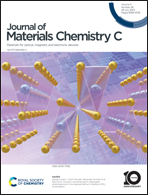A feasible strategy to obtain air-stable triphenylamine radicals in the solid state by introducing conjugated donor–acceptor modules†
Abstract
In recent years, organic radicals have gained considerable attention because they open opportunities for new-generation electronics which may integrate spin, magnetic and quantum mechanical effects. However, air stable organic radicals in the solid state, which can be practically applied, remain a great challenge in chemistry. Herein, we choose N-heptanamido triarylamine as a fragment which can produce radicals upon light irradiation, phenothiazine as a donor (D) unit, and 3-ethylrhodanine or 1,3-indanedione as an acceptor (A) unit, and then connect them in a conjugated manner. The results of 1H-NMR spectroscopy, DFT calculations, EPR measurements, AFM and photophysical characterization revealed that the introduction of the D unit could significantly increase spin delocalization and then the stability of the light-triggered TPA radicals in chloroform solution. These radicals can be maintained in the solid state. More importantly, these become stable radicals with a half-life of approximately one month under ambient conditions due to the stronger intermolecular aggregation resulting from the introduction of the A unit. This work provides a new approach for obtaining air-stable radicals in the solid-state from organic radicals in solution.



 Please wait while we load your content...
Please wait while we load your content...